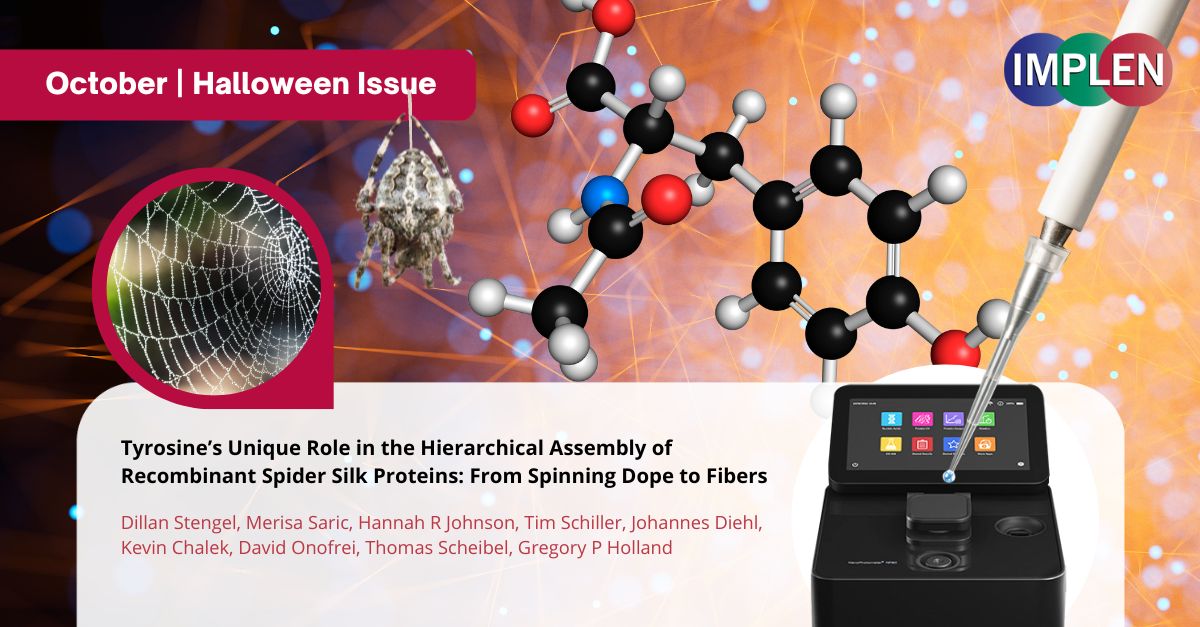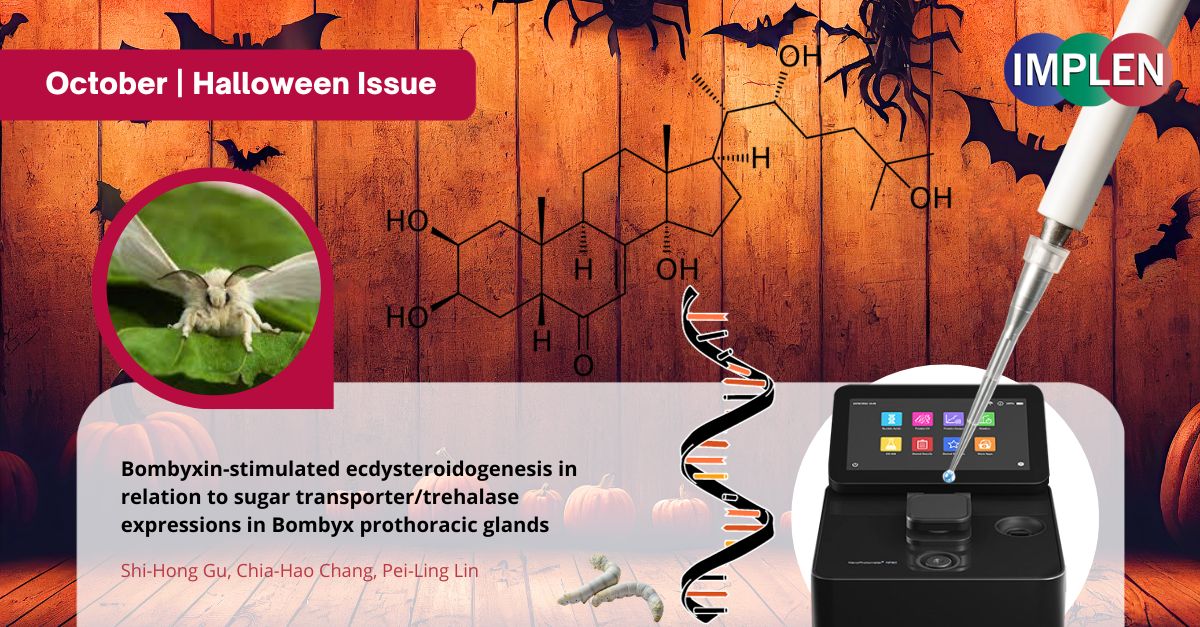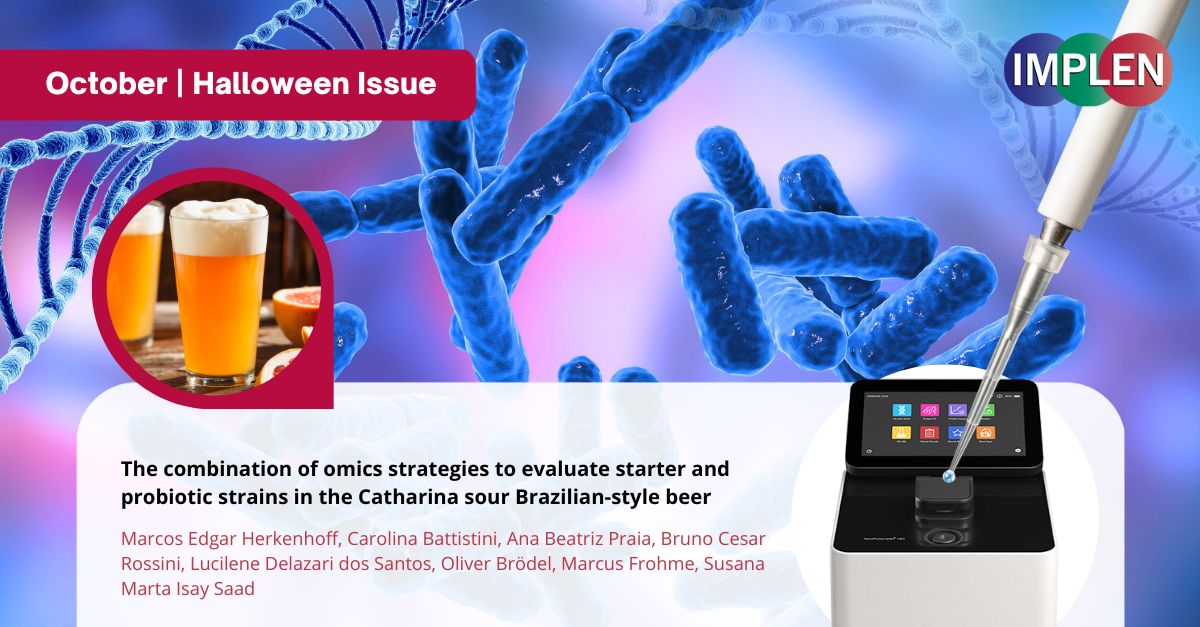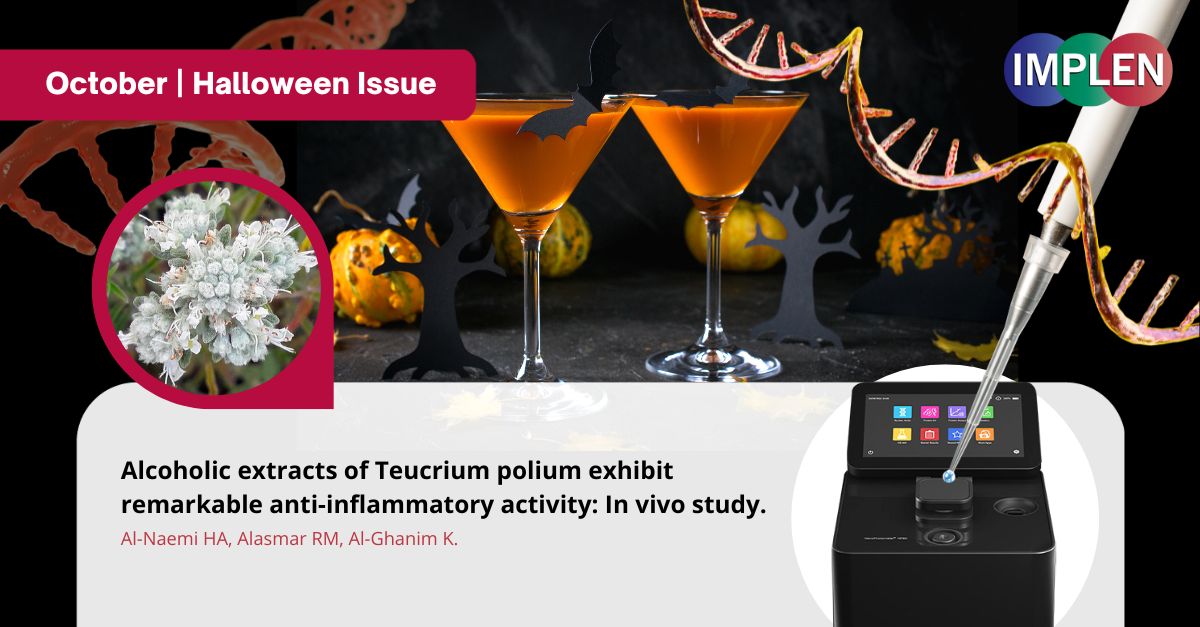Implen Journal Club | October Issue Halloween Edition |
|
Tyrosine's Key Role in the Hierarchical Assembly of Recombinant Spider Silk Proteins: Insights from the Study by Stengel et al.Introduction: This week's Implen NanoPhotometer Journal Club dives into the captivating realm of spider silk, shedding light on the critical role of tyrosine in the assembly process of recombinant spider silk proteins. Renowned for its exceptional strength and elasticity, spider silk is a highly sought-after material with applications spanning from textiles to medical devices. Research Focus: A study conducted by Stengel et al. delves deep into the hierarchical assembly of spider silk proteins, replicating the natural silk production process of spiders. Notably, this study examines the unique role of the amino acid tyrosine in this assembly. The recently published research in the journal Biomacromolecules investigates how varying concentrations of tyrosine influence the spinning dope, a semi-liquid silk precursor, and its subsequent transformation into fibers. Impact of Tyrosine Concentration: The study's findings reveal that tyrosine concentration significantly influences the physical characteristics of the resulting fibers. Elevated levels of tyrosine enhance critical mechanical properties, including tensile strength and elasticity. These results underscore the pivotal role of tyrosine in optimizing the mechanical performance of synthetic spider silk fibers. Broader Implications: The significance of this research extends beyond synthetic spider silk production. Understanding the influence of tyrosine in the hierarchical assembly of proteins holds promise for diverse applications in bioengineering and materials science. This work unlocks fresh possibilities for revolutionizing the development of spider silk-based materials, with superior mechanical properties, thereby paving the way for innovative applications tailored to recombinant proteins in a wide range of industrial and medical uses. Instrumentation: The NanoPhotometer played a crucial role in this study by measuring spider silk dope concentrations with precision. |
|
Bombyxin-Stimulated Ecdysteroidogenesis and Halloween Genes in Insect MetamorphosisIntroduction: This week's edition of the Implen NanoPhotometer Journal Club, Halloween Edition, delves into the fascinating world of insects and their astounding transformations orchestrated by the "Halloween genes." These genes, aptly named for their role in insect metamorphosis, are central to the intricate costume changes during development. Research Study: Shi-Hong Gu, Chia-Hao Chang, and Pei-Ling Lin conducted a study to investigate the relationship between Bombyxin-stimulated ecdysteroidogenesis and the expression of sugar transporter and trehalase genes within the Bombyx prothoracic glands. Ecdysteroids and Halloween Genes: Ecdysteroids, the pivotal hormones regulating these remarkable transformations, are synthesized through a complex biosynthetic pathway. The Halloween genes encode essential enzymes, enabling the conversion of dietary cholesterol into ecdysteroids. Key Findings: This research uncovers how the Halloween genes are integral to Bombyxin-stimulated ecdysteroidogenesis and its association with sugar metabolism within the prothoracic glands of Bombyx mori, commonly known as the silkworm. Significance: Understanding the role of Halloween genes is crucial, as they are central to ecdysteroid production, governing pivotal developmental processes in insects. This knowledge not only deepens our comprehension of insect metamorphosis but also holds promise for applications in agriculture, pest control, and sericulture by providing insights into silkworm growth and development regulation. Use of NanoPhotometer®: The NanoPhotometer played a vital role in this study, enabling precise determination of RNA concentrations. |
|
Omics Strategies to Evaluate Starter and Probiotic Strains in Catharina Sour Brazilian-Style BeerIntroduction: The Implen NanoPhotometer® Journal Club: Oktoberfest Issue spotlights recent research by Marcos Edgar Herkenhoff et al. published in Food Research International. This study delves into omics strategies assessing the efficacy and impact of starter and probiotic strains in Catharina sour Brazilian-style beer production. Bridging traditional brewing practices with modern microbiological techniques, this research aims to enhance beer quality and nutritional value.
Research Study:Catharina sour Brazilian-style beer, renowned for its low alcohol content and high acidity, holds immense popularity among consumers. The research employs various omics approaches—genomics, metagenomics, transcriptomics, and metabolomics—to thoroughly analyze microbial communities, gene expression, and metabolite profiles throughout the beer fermentation process. Key Findings: The study illuminates the potential of probiotic strains in amplifying beer's health benefits. These strains play a vital role in producing bioactive compounds that positively affect human gut microbiota. By utilizing omics techniques, researchers pinpoint specific genes and metabolites associated with probiotic activity, unraveling the molecular mechanisms behind these health-promoting properties. Integrating omics strategies offers a comprehensive view of intricate microbial interactions during brewing, presenting a valuable tool for quality control in beer production. This integrated approach aids in selecting probiotic and starter strains that enhance not only beer quality but also its nutritional value. The research underscores the brewing industry's potential for innovation, showcasing how modern molecular techniques complement traditional brewing practices, ultimately yielding healthier and more flavorsome beer products. Use of NanoPhotometer®: Furthermore, the study emphasizes accurate measurements of nucleic acid concentration, purity, and quality using the NanoPhotometer® N60 spectrophotometer. |
|
Halloween Edition - Teucrium Polium: A Natural Anti-Inflammatory RemedyIntroduction: Welcome to this week's special Halloween edition of the Implen NanoPhotometer Journal Club! In this spooktacular installment, we dive into the intriguing realm of Teucrium polium, a plant traditionally used in the Middle East, which might just be the answer to your quest for an anti-inflammatory elixir. We're not talking about ghostly spirits here, but the bioactive kind. Recent research by Al-Naemi et al. in the Biomolecules and Biomedicine journal uncovers the potential of Teucrium polium as a powerful anti-inflammatory remedy. Anti-Inflammatory Powerhouse: The study involved inducing inflammation in rats and administering Teucrium polium extracts to different groups. The results were astonishing, with the groups treated with these extracts showing significantly reduced inflammation compared to the control group. Notably, the highest extract dose exhibited even stronger anti-inflammatory effects than meloxicam, a widely-used anti-inflammatory drug. Teucrium polium managed to inhibit inflammation by over 80%, surpassing meloxicam's 60% reduction. Moreover, these extracts effectively lowered the levels of inflammatory proteins such as TNF-alpha and IL-1beta, while simultaneously boosting the production of an anti-inflammatory protein known as IL-10 in inflamed tissues. Additionally, the extracts demonstrated their prowess by suppressing other inflammatory markers, including IL-6, TNF-alpha, MCP-1, and NF-kB. Key Findings: This groundbreaking study provides compelling evidence of Teucrium polium's significant anti-inflammatory properties, partially attributed to its ability to increase IL-10. The dose-response effects observed hint at the presence of potent bioactive compounds within the plant. This research sheds light on the molecular mechanisms underpinning Teucrium polium's traditional medicinal use and underscores its immense anti-inflammatory potential, offering hope for the development of new natural remedies. NanoPhotometer® in Action: Worth noting, the researchers harnessed the power of the NanoPhotometer in their investigation, utilizing it to measure mRNA concentration and quality, showcasing its invaluable role in this groundbreaking research. |
©2023 Implen. All rights reserved.



